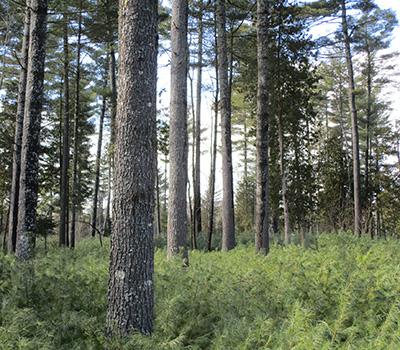Managing an Aging Resource: Influence of Age on Leaf Area Index, Stemwood Growth, Growth Efficiency, and Carbon Sequestration of Eastern White Pine

The eastern white pine resource of New England, once dominated by sapling and pole-sized stands of old-field origin, has largely matured to sawtimber-sized stands. Should these aging stands be regenerated as rapidly as possible, as traditional timber management theory suggests, or can they be kept on much longer rotations, maintain excellent growth rates, and continue to sequester large quantities of carbon? To answer this question, NSRC researchers studied the production ecology of white pine over a complete range of ages (a so-called “chronosequence”), from newly regenerated sapling stands to the old-growth stage of 200 years and beyond.
Over 25 years ago, NSRC researcher Robert Seymour began a long-term study of eastern white pine on the University of Maine’s Demeritt Forest. For the current study, researchers re-measured study plots, quantified effects of tree age and stand density on leaf area index, and quantified stemwood and above-ground productivity (biomass, carbon) and growth efficiency over a 200+-year chronosequence. Researchers monitored leaf area index by uninterrupted semi-annual litterfall collections using trap boxes permanently placed beneath the trees and measured trees to determine tree growth.
Findings indicate that eastern white pine is perhaps the most productive species in the Northeast based on stemwood volume, growth, dry mass, and carbon. Fully stocked old stands continue to accumulate stemwood biomass and carbon to at least age 210. Researchers suggest that combining a long-rotation silvicultural system aimed at producing large pine sawlogs, with carbon offset payments to keep some of this carbon “on the stump” and growing, might be a win-win strategy for New England’s white pine resource.
